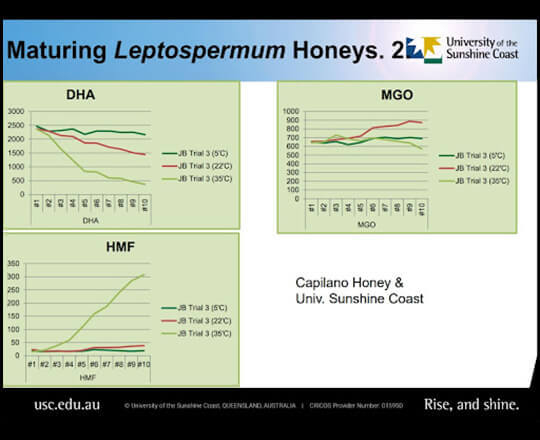All raw honey has medicinal properties when ingested or put on wounds through the non-peroxide effect. This effect is increased when the methylglyoxal Compound is increased.
So to understand the difference between MGO and UMF, we need to learn a couple of different things like DHA, HMF and why and who uses UMF, why not just MGO. To get a better understanding of honey and there benefits, read our article on What are the benefits of raw honey and medihoney
MGO
MGO is an abbreviation for the compound methylglyoxal that is found in leptospermum Honey. So this is what is used to grade the quality of leptospermum honey. This grading starts at 85 MGO and goes up to 1200+ MGO (refer to table showing MGO to UMF)
UMF
UMF is an abbreviation of Unique Manuka Factor. It is the standardised grading measurement of the Unique Manuka Factor Honey Association (UMFHA) of New Zealand and is trademarked as such. This means for the rest of us we need to use MGO. The grading of UMF starts at 0 and can go up to 30+ (more commonly only to 25+). So, as you might know, New Zealand has a history of clever trademarking and marketing to sell products just like the little-known Chinese gooseberry or better known as Kiwifruit. But that is where the benefits of UMF end as the world understands MGO better. People now are realising that it is not Manuka that you want, it is Leptospermum.
DHA
Knowing that MGO is the same as UMF, but the numbering is different. We need to look at DHA (Dihydroxyacetone). The methylglyoxal (MGO) in Honey is derived from DHA in Nectar from the plant. This means honey when collected, that has a high DHA will mature into a higher MGO rating which brings us to Maturing honey.
HMF
HMF or 5-hydroxymethylfurfural is formed from reducing sugars in honey and heat. So in good quality raw honey, the HMF is very low, under ten means that it has NOT been heated at all or mixed with sugars to bulk up the honey.
“An artificial honey mixture was prepared by adding gluconic acid lactone to sterile deionised water until pH 3.8 was achieved following lactone hydrolysis. To 17.5mL of the gluconic acid solution, 40g fructose, 36.2g glucose and 2.8g sucrose were added and heated to 50o C to dissolve the sugars. This typical honey solution was used in the standard assay procedure to determine the effect of sugar concentration or acidity on antimicrobial activity.”
Artificial honey - “The Use of Australian Honey in Moist Wound Management” by Craig Davis - June 2002
Studies conducted by Simon Williams and the University of the Sunshine coast show that MGO will increase in potency when stored in the right conditions over 12 months (as shown in the above graph). They also learnt in these trials that temperature also affects the result and can be shown in HMF.

Breakdown of temperatures:
- At 5℃ MGO and DHA stay at the same value.
- At 22℃ DHA decreased and MGO increased. (optimal temperature)
- At 35℃ DHA decreased rapidly and MGO after an initial small rise values fell destroying the honey.
*Source Australian Leptospermum Honeys powerpoint by Dr Peter Brooks University of the Sunshine Coast
Meaning heating honey is bad and will hurt the quality that is why at Goodwood Produce all our honey is harvested and stored without applying any heat whatsoever not even a hot knife when extracting. As the honey metures the DHA will lower producing a higher MGO levels. This means we can look at the DHA value in a plant and know what the likelihood of MGO honey is going to be if collected. Then after harvest, most MGO honey like Goodwood produce’s honey is tested by the likes of University of the Sunshine Coast. Then again, after 12 months to see the end rating of the MGO honeyhoney before packing to be sold.
| MGO | UMF |
| 85+ | 5+ |
| 260+ | 10+ |
| 515+ | 15+ |
| 830+ | 20+ |
| 1200+ | 25+ |
*Source Australian Leptospermum Honeys by Dr Peter Brooks University of the Sunshine Coast
Leptospermum Varieties
For New Zealand this is there problem and why they push so hard for it to be called Manuka Honey or UMF and that is because in New Zealand they only have 2 types of leptospermum trees which are Manuka and Kanuka and only one of which when bees collect from it produces methylglyoxal (MGO) and you guessed it Manuka is the one. Where in Australia there are 83 species of leptospermum tree with at least 24 that when collected from them produce MGO honey with more being discovered all the time.
MGO producing leptospermum trees and there DHA value
|
*Source for DHA Levels from ‘A Beekeeper’s Guide to Australian East Coast Leptospermum Trees and Honey’
- Manuka (NZ main species)
- Jellybush (Goodwood Produces Main species)
Note: That most Leptospermum varieties don't have a unique common name and in a lot of cases get lumped into one and called Tea-tree.
The main Leptospermum varieties our bees collect from at Goodwood Produce are L. Polygalifolium, L. Whitei and L. speciosum. So if you are after good quality MGO honey, make sure you stop by for a chat or Contact us.

